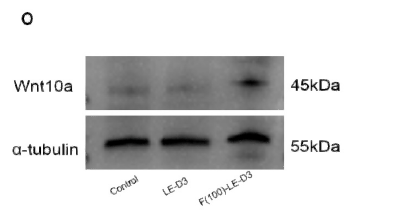WN10A Polyclonal Antibody
- Catalog No.:YN0283
- Applications:WB;ELISA
- Reactivity:Human;Mouse;Goat;Human
- Target:
- WN10A
- Fields:
- >>mTOR signaling pathway;>>Wnt signaling pathway;>>Hippo signaling pathway;>>Signaling pathways regulating pluripotency of stem cells;>>Melanogenesis;>>Cushing syndrome;>>Alzheimer disease;>>Pathways of neurodegeneration - multiple diseases;>>Human papillomavirus infection;>>Pathways in cancer;>>Proteoglycans in cancer;>>Basal cell carcinoma;>>Breast cancer;>>Hepatocellular carcinoma;>>Gastric cancer
- Gene Name:
- WNT10A
- Protein Name:
- Protein Wnt-10a
- Human Gene Id:
- 80326
- Human Swiss Prot No:
- Q9GZT5
- Mouse Swiss Prot No:
- P70701
- Immunogen:
- Synthesized peptide derived from human protein . at AA range: 110-190
- Specificity:
- WN10A Polyclonal Antibody detects endogenous levels of protein.
- Formulation:
- Liquid in PBS containing 50% glycerol, and 0.02% sodium azide.
- Source:
- Polyclonal, Rabbit,IgG
- Dilution:
- WB 1:500-2000 ELISA 1:5000-20000
- Purification:
- The antibody was affinity-purified from rabbit antiserum by affinity-chromatography using epitope-specific immunogen.
- Concentration:
- 1 mg/ml
- Storage Stability:
- -15°C to -25°C/1 year(Do not lower than -25°C)
- Observed Band(KD):
- 45kD
- Background:
- The WNT gene family consists of structurally related genes which encode secreted signaling proteins. These proteins have been implicated in oncogenesis and in several developmental processes, including regulation of cell fate and patterning during embryogenesis. This gene is a member of the WNT gene family. It is strongly expressed in the cell lines of promyelocytic leukemia and Burkitt's lymphoma. In addition, it and another family member, the WNT6 gene, are strongly coexpressed in colorectal cancer cell lines. The gene overexpression may play key roles in carcinogenesis through activation of the WNT-beta-catenin-TCF signaling pathway. This gene and the WNT6 gene are clustered in the chromosome 2q35 region. [provided by RefSeq, Jul 2008],
- Function:
- disease:Defects in WNT10A are the cause of odonto-onycho-dermal dysplasia (OODD) [MIM:257980]. OODD is a rare autosomal recessive ectodermal dysplasia in which the presenting phenotype is dry hair, severe hypodontia, smooth tongue with marked reduction of fungiform and filiform papillae, onychodysplasia, keratoderma and hyperhidrosis of palms and soles, and hyperkeratosis of the skin.,function:Ligand for members of the frizzled family of seven transmembrane receptors.,function:Ligand for members of the frizzled family of seven transmembrane receptors. Probable developmental protein. May be a signaling molecule important in CNS development. Is likely to signal over only few cell diameters.,similarity:Belongs to the Wnt family.,
- Subcellular Location:
- Secreted, extracellular space, extracellular matrix . Secreted .
- Expression:
- Brain,Pancreas,Placenta,Skin,Thymus,
MiR-19 3b regulated the formation of coat colors by targeting WNT10A and GNAI2 in Cashmere goats. ANIMAL BIOTECHNOLOGY 2021 Nov 08 WB Goat,Human Skin HaCaT cell
Fullerol rescues the light-induced retinal damage by modulating Müller glia cell fate. Redox Biology Haiwei Xu WB 1:500
- June 19-2018
- WESTERN IMMUNOBLOTTING PROTOCOL
- June 19-2018
- IMMUNOHISTOCHEMISTRY-PARAFFIN PROTOCOL
- June 19-2018
- IMMUNOFLUORESCENCE PROTOCOL
- September 08-2020
- FLOW-CYTOMEYRT-PROTOCOL
- May 20-2022
- Cell-Based ELISA│解您多样本WB检测之困扰
- July 13-2018
- CELL-BASED-ELISA-PROTOCOL-FOR-ACETYL-PROTEIN
- July 13-2018
- CELL-BASED-ELISA-PROTOCOL-FOR-PHOSPHO-PROTEIN
- July 13-2018
- Antibody-FAQs
- Products Images

- Fullerol rescues the light-induced retinal damage by modulating Müller glia cell fate. Redox Biology Haiwei Xu WB Mouse,Human 1:1000 eyes MIO-M1 cell

- Western blot analysis of lysates from K562 cells, primary antibody was diluted at 1:1000, 4°over night



